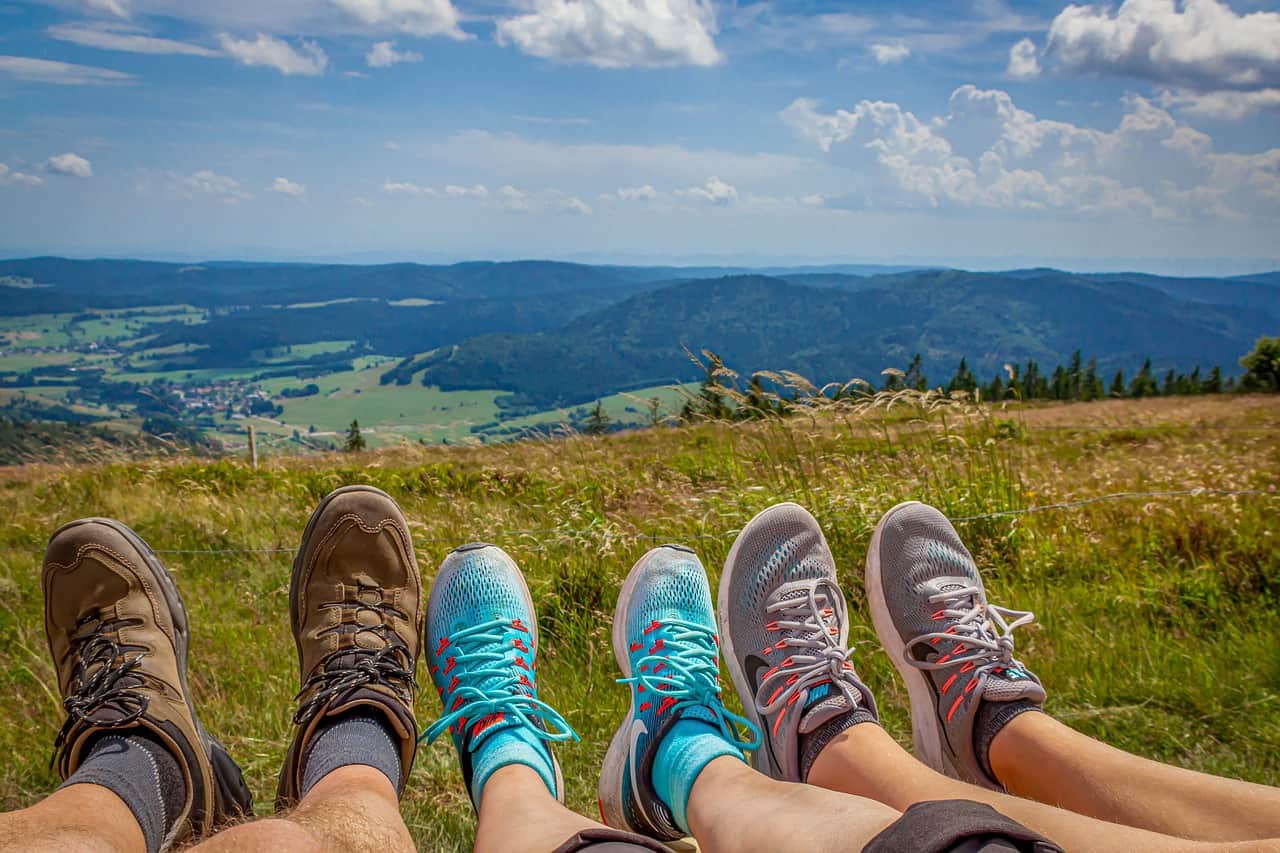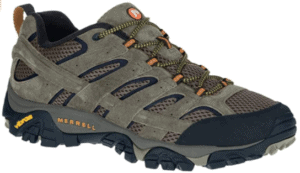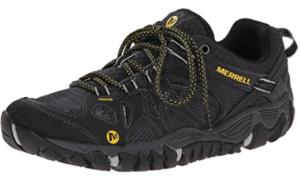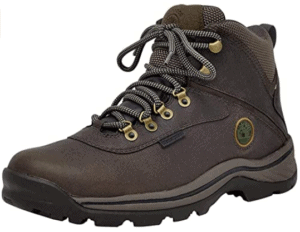Often times beginning hikers wonder if you can hike with running shoes, as this is what they have laying around the house.
Whether or not you can wear running shoes while hiking though is more than just a simple yes or no answer as there are several things you must consider before deciding.
In general, it’s ok to wear running shoes while hiking when first starting out and hiking on trails that are shorter and less rugged. However, as you gain experience as a hiker and the length and level of difficulty of the trails begin to increase, it’s a good idea to upgrade to a pair of trail running shoes or hiking boots.
6 Things to Consider Before Hiking with Running Shoes
Running shoes, in general, will offer the least amount of protection for your feet and ankles while hiking so if you are going to wear running shoes while hiking, there are 6 things you must consider before deciding, in order to safe and injury-free.
Length of the Hike
The first thing to consider when deciding on whether or not it’s ok to wear running shoes while hiking is the length of the hike. If the hike you’re planning is less than 1 or 2 hours and not more than a few miles than you should be fine hiking in running shoes.
If however, the hike is an all-day hike or is greater than 3 or 4 miles than you might want to consider upgrading to a good pair of trail running shoes or hiking boots.
Type of Hike
Hiking can mean everything from a leisurely stroll through nature to a rigorous expedition across the countryside and everything in between. So when deciding on whether or not to wear running shoes while hiking, make sure to take into account the type of hike your going on.
If you’re taking a leisurely stroll through the woods to enjoy wildlife and the sights and sounds of nature, then running shoes, should be more than adequate on your hike.
If however, your hike is a rigorous and rugged hike, that is both physically demanding and long then trekking running shoes or boots will be a more appropriate choice.
Elevation Change of the Trail
Another consideration to help you choose the appropriate footwear while hiking is the elevation change of the trail you plan to hike. This is because running shoes do not offer a lot of tread or traction for large elevation changes while hiking up and down steep hills.
So if the trail you’re going to hike is filled with large elevation changes and steep inclines or declines, it’s best to avoid wearing running shoes, as they will not provide the traction you will need to safely traverse the elevation changes on the trail.
If however, the trail is mainly flat with little to no elevation change then running shoes should be fine.
A good rule of thumb when trying to choose appropriate footwear based on the elevation change of a trail is if the trail has less than 500 feet in elevation change, running shoes should be fine. If however, the trail has more than 500 feet of elevation change then you should consider upgrading from the basic running shoe.
Ruggedness of the Trail
Even if the trail happens to be relatively short with little to no elevation change, running shoes may still not be a good idea depending on the ruggedness of the trail. As running shoes typically use very thin and lightweight materials to keep the weight of the shoe down, which is great for running but not so great when you are traversing over rough trails or rock scrambling.
Also, due to the lack of ankle support in running shoes, it can be very easy to roll or twist an ankle on rough trails or while rock scrambling.
Water Crossings
If the trail you plan to hike has you crossing streams or is around water or waterfalls, you might want to reconsider running shoes as they can quickly become saturated and can take a very long time to dry when wet.
Instead, it’s a better idea if you plan to cross any streams or bodies of water while hiking to wear a trail running shoe or hiking boot that has some level of waterproofing built into them and dry out fast if they get wet. As there is no worse feeling and no quicker way to develop blisters than hiking in waterlogged shoes.
In fact, if you know you will be dealing with wet trails or a lot of water while hiking you might even want to consider a shoe specifically designed for water such as the Merrell All Out Blaze Aero Sport Hiking Water Shoes. ((Which you can check out on Amazon by clicking here.)) As these hiking water shoes are specifically designed to stay dry for longer and dry out quicker if they do get wet.
Weather
The last thing you should take into consideration before deciding to wear running shoes while hiking is the weather that is expected while hiking.
As was the case with large or steep elevation changes, due to the lack of traction and grip on most running shoes, when the weather turns wet and the trails turn muddy, it’s best to leave the running shoes at home and instead opt for a shoe or boot with more traction such as a trail running shoe or hiking boot.
What’s the Difference Between Hiking Shoes and Running Shoes?
When it comes to hiking shoes versus running shoes there are many differences that set these two types of shoes apart from one another including their tread, type of mesh, toe protection, and ankle support.
Tread
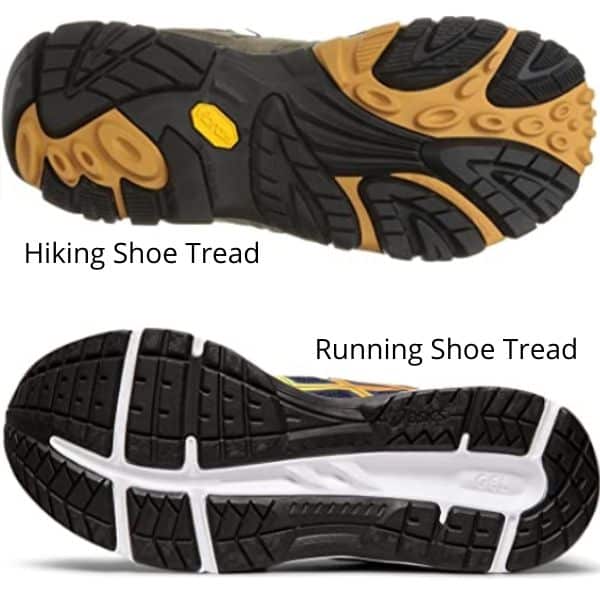
Typically hiking shoes or trail running shoes have a much more aggressive and pronounced tread compared to standard running shoes. This allows hiking shoes to provide much better grip and traction over rough and uneven terrain reducing the likelihood of slips and falls while hiking.
Type of Mesh
While you might assume there isn’t much difference in mesh from one shoe to the next, there can actually be quite a bit of difference in the mesh of a hiking shoe compared to the mesh of running shoe.
For starters, typical running shoes have very soft and open mesh designs that help to reduce the overall weight and increase airflow into the shoe, however, as a byproduct of this, the mesh can easily get snagged or scraped causing a puncture or tear in the mesh.
While mesh on trail running shoes also allow for breathability they have a much tighter and durable mesh design, that holds up better to scrapes and punctures and drys out much faster in the event the shoe gets wet.
Toe Protection
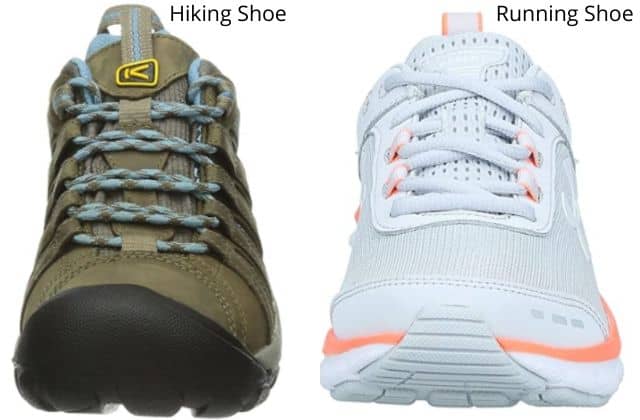
Another noticeable difference between hiking shoes and running shoes is the amount of toe protection the shoe provides, which you can clearly see from the photo above.
As you can see the hiking shoe on the left offers much thicker and larger protection for your toes by encasing the whole front of the shoe with thick rubber.
While the running shoe on the right offers minimal protection for your toes compared to the hiking shoe.
Ankle Support
The last major difference between hiking shoes or trail running shoes and standard running shoes is the difference in ankle support.
While both types of shoes offer some level of ankle support, hiking shoes typically offer far more ankle support compared to typical running shoes and can go along way in preventing injury to your ankles while hiking.
What Kind of Shoes are Good for Hiking?
There are 4 main types of shoes that are good for hiking including hiking shoes, trail running shoes, hiking water shoes, and hiking boots, and each type of hiking shoe offers its own unique set of advantages and disadvantages as you will see below.
Hiking Shoes
The hiking shoe like this one from Merrell is a great all-around shoe that offers a lot of durability, comfort, and flexibility while hiking on the trails. ((To see this popular hiking shoe on Amazon click here.))
Hiking shoes typically have a mid-top design, a durable and rugged upper made from a combination of suede and mesh, a thick rubber sole, and an aggressive and pronounced tread pattern.
Hiking shoes are great for all types of hiking and are the most versatile of all the hiking shoes.
Advantages
- Excellent versatility and great for all hiking conditions.
- Rugged and durable design holds up well to trail hiking.
- Offers a good compromise between weight and ruggedness.
- Provide a good level of cushioning.
Disadvantages
- Bulkier and heavier design compared to trail running shoes or hiking water shoes.
- Usually offer some level of water resistance but are not typically waterproof.
Trail Running Shoes
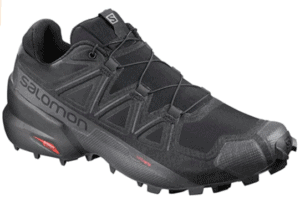
The trail running shoe like this one by Salomon is similar to the hiking shoe as they both have a rugged design and aggressive tread pattern, but the trail running shoe tends to be more streamlined, less bulky, and lighter compared to the standard hiking shoe. ((To check the price of this high-end trail running shoe on Amazon click here.))
Trail running shoes usually have either a low-top or mid-top design, a durable upper that is a combination of either canvas or leather and mesh, have a moderately thick foam or rubber sole, and an ultra-aggressive and pronounced tread pattern.
Trail running shoes are great for hikers that are more concerned with performance and speed than with comfort while on the trails.
To see some of the best trail running shoes currently on the market today check out this super informative YouTube video.
Advantages
- Great for speed and performance while hiking.
- Lightweight option that can help reduce tiredness and fatigue over long hikes.
- Very durable and rugged design that holds up well to hiking and rock scrambling.
Disadvantages
- While comfortable they don’t have as much cushioning when compared to standard hiking shoes.
- Offers some level of water-resistance but usually not completely waterproof.
Hiking Water Shoes
Hiking water shoes like this one by Merrell are great when hiking through or around water all-day. ((To check the price of this well made and popular hiking water shoe on Amazon click here.))
Compared to waterproof hiking boots, hiking water shoes take a much different approach to water as they are not actually waterproof but instead are made from materials that hold up well in water and drain and dry quickly when they get wet.
Hiking water shoes usually have either a low-top or mid-top design, have a combination of waterproof leather and quick-drying mesh upper, have a moderately thick and lightweight synthetic sole, and a mildly aggressive tread pattern.
Hiking water shoes are great for hikers that want a hiking shoe that holds up well to water and drys quickly without having all the extra weight and bulkiness of a waterproof hiking boot.
Advantages
- Great for wet weather and water crossings.
- Drain and dry the fastest out of all the hiking shoes.
- Lightweight design helps reduce fatigue and tiredness.
Disadvantages
- Does not offer as much comfort or cushioning compared to the traditional hiking shoe.
- Holds up well to water and dry’s quickly but the shoe is not waterproof if you want to keep your feet dry while crossing water.
Hiking Boots
The classic hiking boot like this one from Timberland has been around for what seems like forever and was the first hiking shoe specifically designed for hiking. ((To check the price of this classic hiking boot on Amazon click here.))
The hiking boot usually has a high-top design, a full leather upper, a thick rubber sole, and a moderately aggressive tread pattern.
The hiking boot is great for hikers that are looking for the ultimate in durability and comfort while hiking. However, many hikers are starting to move away from the traditional hiking boot due to their heavyweight and bulkiness.
For an example of this listen below to why one hiker said she switched from hiking boots to trail runners that has hiked the Appalachian Trail.
Advantages
- Provides a lot of comfort while on the trails and is easy on the feet, thanks to its think rubber sole and ample cushioning.
- While not always the case most hiking boots are completely waterproof making them great for water crossings and wet conditions.
- Due to the rugged construction of the hiking boot with its thick rubber sole and all-leather upper, the classic hiking boot is the most durable and reliable hiking shoe.
- The high-top design of the hiking boot offers the most ankle support and protection of all the hiking shoes.
Disadvantages
- Many hikers have moved away from the traditional hiking boot as they are by far the heaviest and bulkiest option when it comes to hiking shoes.
- While the high-top design is great for ankle support, hiking boots can feel very restrictive when hiking steep terrain or rock scrambling as they allow for the least amount of ankle movement while hiking.

